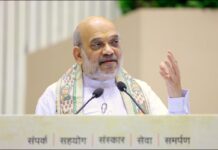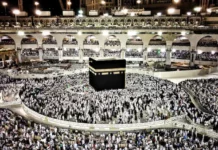 WASHINGTON: The number of Hindus migrating to the US every year has more than doubled in the last one decade, with an overwhelming majority of them coming from India, a new study says.
WASHINGTON: The number of Hindus migrating to the US every year has more than doubled in the last one decade, with an overwhelming majority of them coming from India, a new study says.
An average of about 30,000 Hindus were admitted each year in the 1990s, by contrast, the US admitted an estimated 70,000 Hindu immigrants in 2012, the prestigious Pew Research Center said in its latest report on religious affiliation of immigrants.
According to the report, the great majority of Hindu immigrants come from India and neighboring countries with significant Hindu populations, such as Nepal and Bhutan.
The share coming from the Caribbean (or “West Indies”) has decreased significantly, dropping from an estimated 16 per cent of all Hindu immigrants to the US in 1992 to five per cent in 2012, it said.
While Christians continue to make up a majority of legal immigrants to the US, the estimated share of new legal permanent residents who are Christian declined from 68 per cent in 1992 to 61 per cent in 2012.
Over the same period, the estimated share of green card recipients who belong to religious minorities rose from approximately one-in-five (19 per cent) to one-in-four (25 per cent).
“This includes growing shares of Muslims (five per cent in 1992, 10 per cent in 2012) and Hindus (three per cent in 1992, seven per cent in 2012).
“The share of Buddhists, however, is slightly smaller (seven per cent in 1992, six per cent in 2012), while the portion of legal immigrants who are religiously unaffiliated (atheist, agnostic or nothing in particular) has remained relatively stable, at about 14 per cent per year,” the report said.
Notably the US government does not keep track of the religion of new permanent residents.
As a result, the figures on religious affiliation in this report are estimates produced by combining government statistics on the birthplaces of new green card recipients over the period between 1992 and 2012 with the best available US survey data on the religious self-identification of new immigrants from each major country of origin, Pew said.
Over the past two decades, the US has admitted an estimated 12.7 million Christian immigrants.
The second-largest religious category among legal immigrants is the unaffiliated, which includes atheists, agnostics and people who do not identify with any particular religion.
In recent years, the share of immigrants who have no religious affiliation has held fairly stable, at about 14 per cent. Since 1992, the US has admitted an estimated 2.8 million religiously unaffiliated immigrants, it said.
Over the same period, the estimated share of legal Muslim immigrants entering the US each year has roughly doubled, from about five per cent of legal immigrants in 1992 to about ten per cent in 2012.
Since 1992, the US has admitted an estimated total of about 1.7 million Muslim immigrants.
Hindu immigrants also have increased in number over the past 20 years, rising from about 3 per cent of new permanent residents in 1992 to seven per cent in 2012.
In that span, the US has admitted nearly a million Hindu immigrants, according to the Pew Research Center’s estimate, the report said.
By contrast, the annual share of Buddhist immigrants has dipped somewhat, going from an estimated 7 per cent of legal immigrants in 1992 (near the end of a wave of refugees from Southeast Asia that began during the Vietnam War) to about four per cent annually a decade ago and about six per cent in 2012.
Over the past two decades, the US has admitted an estimated total of about 1 million Buddhist immigrants – approximately the same as the number of Hindus.
“The estimated share of immigrants of all other religious groups, including Jews, Sikhs and adherents of Chinese folk religions, has remained relatively stable over the past 20 years, at roughly three per cent of new permanent residents.
Since 1992, the US has admitted an estimated 600,000 immigrants who belong to these groups,” the report said. -PTI






